#what did I do to invoke this martyrdom disease?
Video
Recently I rewatched Kazekage rescue arc and I like this conversation of Kakashi and Chiyo, because of these some interesting things :
1. Chiyo “allergic to ninjas from other village” asks Kakashi about a trivial thing (I mean in their situation it’s hardly the time to have heart to heart) without hesitation, especially since their first meeting is not going well. Their first interaction is not going well at all, with Kakashi somehow getting mistaken as his father with only his one eye and hair visible.

Offf.. In here Chiyo used Shiroi Kiba me that is basically translated as White Fang (derogatory). Since me here is derivative of teme which is widely known as an insulting word.
2. Although in here Kakashi became Naruto’s mouthpiece, at the same time he shows how close he watches Naruto and his behavior after 2.5 years being separated.
3. Gaara’s status at that time is a Kazekage. Literally in the same high position as Tsunade. Temari and Kankuro called him “Gaara” is understandable because they’re his siblings, Sakura and Naruto called him “Gaara” is somewhat understandable because they are teenagers and don’t really care for formalities, Chiyo called him “Gaara” is also understandable because she’s one of Suna Elders and way on senior position than Gaara in Suna Council. But Kakashi, an outsider Jonin leader who know shinobi formality like a back of his hand called him “Gaara-kun” is baffling but also cute.
4. Chiyo suddenly opened herself and talking about her past mistakes, having some thought about maybe they way she supported Sunagakure all this time has been mistaken (isn’t it count as treasonous thoughts? She wasn’t afraid that Kakashi will tell anyone about it?), even uttering her envy for young people, a truly vulnerable things to be admitted for an energetic grandma who just few chapter before said that she will not lose by the youngsters, while Kakashi patiently listened to her.
This is so jarring for me because it’s so weird that hardened shinobi like Chiyo let out her emotional vulnerability to a person whom moments before she thinks as her enemy. It’s as if Kakashi also has emotional power that is similar yet different with Naruto’s. Kakashi said that Naruto has mysterious power that made people instantly befriend him although he only exchanges few words. I think the reason is because Naruto wears his heart on his sleeve. People who met him can see his determination, his pure intention, and that’s why they trust him and open up to him.
But Kakashi is like the most secretive shinobi in Naruto verse. He never said anything about himself, he has some disturbing monikers like Cold-Blooded and Friend-Killer, and he even never let other sees his face. Yet people like Chiyo and Zabuza, hardened veterans who know better than bare their weakness in front of enemy, shows their vulnerable side in front of Kakashi, somehow believes that Kakashi will not betray their trust and use that for his own gain. This Kakashi trait is mentioned in Kakashi Retsuden by Nanara’s P.O.V
Truthfully, he knew nothing about Kakashi. Even if he asks him, he is always deflecting from answering. Thinking about it now, it wouldn't be surprising if he really was a spy sent by the capital.
However, I don't know why, I want to trust him.
I want to follow his back. The so-called excellent leaders must be people like Kakashi.
Yeah, thing is, people who met Kakashi, see his lanky form, unkept hair, covered face, massively secretive attitude, yet somehow feel like he’s a trustworthy and reliable person. Someone that can be depended upon. Like Chiyo, Zabuza, even the Raikage. Of course, his record as elite Jounin help him to get credence for other people, but it’s amazing that even for shinobis from other villages, Kakashi is someone who is least likely to betray them and make them feel safe enough to show vulnerability. Probably this special power also made people dump responsibility over responsibility for him despite his unwillingness XD
5. Kakashi cheered her up and uplifted her spirit, although just a day before he heard the same Chiyo scorned his father’s name with hate. I mean, forgiving is one thing, but no one ask him to be kind for someone who hates his own father, especially since his father is such a sore spot for him. But he did it anyway, made Chiyo laugh, and since that time determined to not give up, do something, and that something is to give her own life for Gaara.
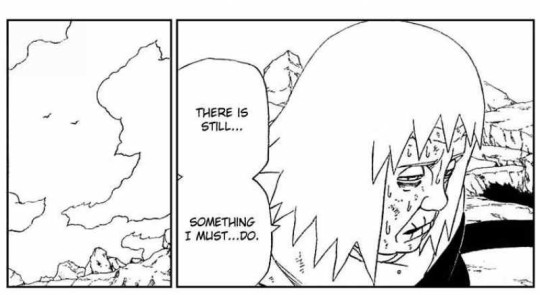
This is just after her fight with Sasori, she already thought to save Gaara.
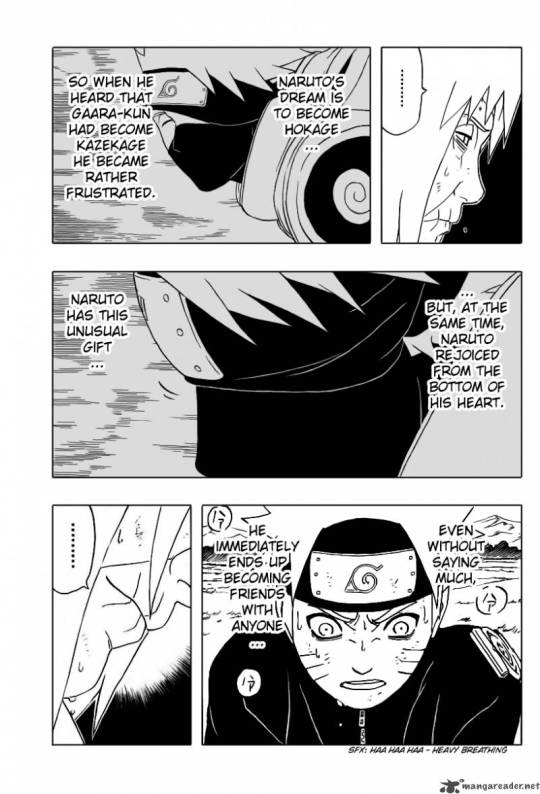
Chiyo rememberes Kakashi’s words in her last moment, saw the proof in front of her eyes, and smiled.

Then Kakashi, as a shinobi through and through, paid respect to Chiyo and complimented her last act as shinobi (although the whole talking about “fitting last moment for a shinobi” is too similar with teenage Kakashi’s favorite book “How a Shinobi should Die” for my comfort. Please tell me that is not your attachment for martyrdom speaking).
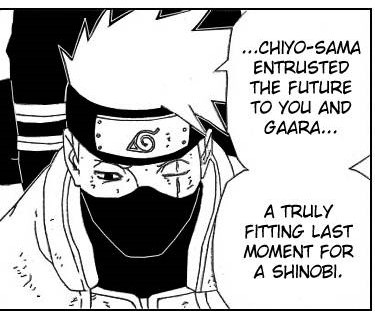
Bonus other Kakashi and Chiyo moments :
Anime only :
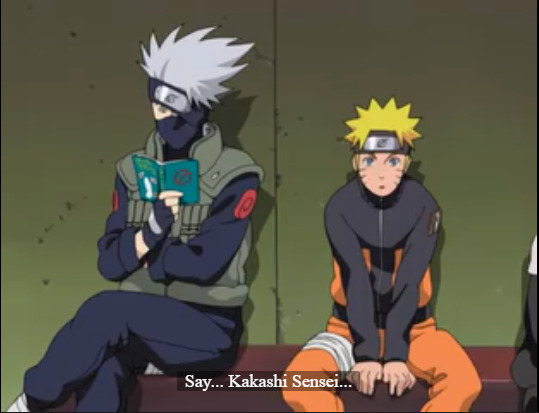
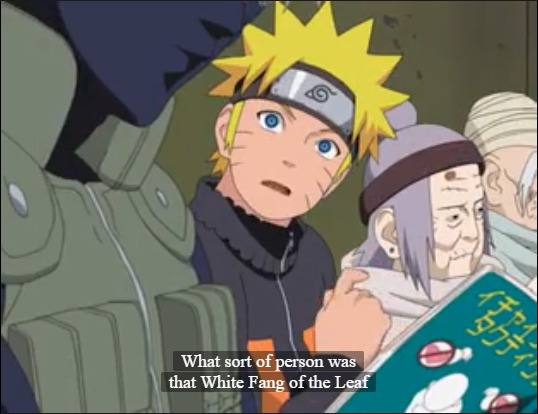





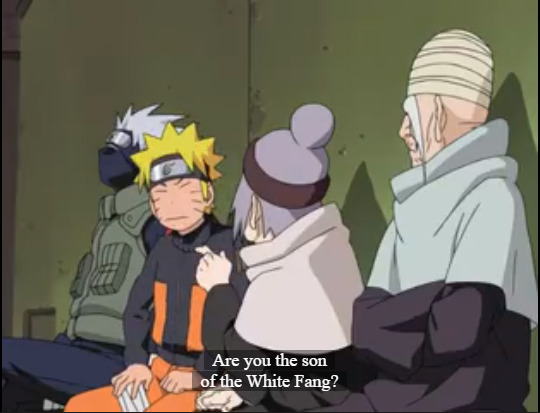

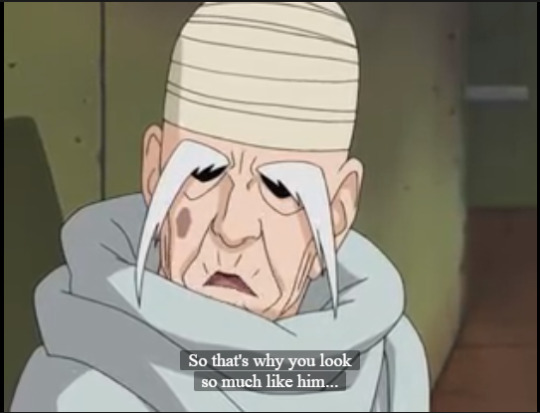

Oh I can feel his awkwardness in this scene. Kakashi’s father is such a sore spot for him (next to Obito and Rin) so maybe it’s truly uncomfortable for him to admit himself as his father’s son in front of a person who was suffered by him. Not that I blame Sakumo, he’s shinobi which means that his situation is constant kill or to be killed in the war, but for me specifically it’s a hard reminder that behind all hero’s glory story there’s someone getting hurt from the other side.
Then when they finally met Team Gai...
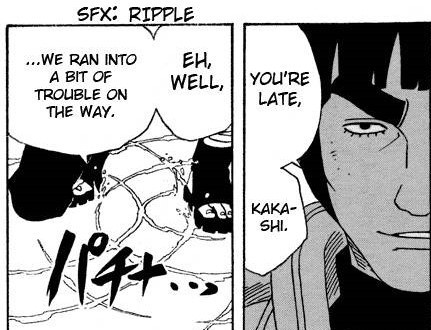

For Konoha people, Kakashi being late and spew offhanded excuse is like running joke, but Chiyo from Suna being typical elderly self conscious and think that she “troubled” Kakashi. That’s so cute of her, almost hoping that Chiyo is my grandma.
In the end, when Chiyo planned to revive Gaara...

Unlike those teenagers who was shocked when Chiyo intended to bring Gaara back, Gai and Kakashi instantly understand that Chiyo would sacrifice her own life for Gaara’s sake. In Kakashi’s case, probably he was having deep thought regarding that, with his solemn closed eye and speech bubble that means thinking.
#hatake kakashi#chiyo#uzumaki naruto#naruto meta#me : intended to make short post about that video#also me : keep typing anything that came in my mind#this is why I am suck at making my own meta post#my though will get jumbled and unorganized#ahhh I don't know#anyway I never appreciate it before but Chiyo is cute#like kind grandma cute#Kakashi bad luck strikes again#Kakashi told her that she was young and there are things that she can do#without knowing that she already has life-transfer jutsu in her arsenal#Kakashi : Is it just coincidence or why is everyone who speaks to me then throw their life for the sake of other people?#what did I do to invoke this martyrdom disease?#independent post
224 notes
·
View notes
Text
Constant Anxiety Won't Save the World
When New York Magazine published a story about the apocalyptic dangers of climate change last month, it was shared widely, and with alarm. People tweeted things like “Read this and get very, very scared,” or otherwise prescribed fear and worry as the appropriate reaction to the piece. They were mimicking the tone of the story itself, which starts by saying “It is, I promise, worse than you think,” and goes on to avow that “no matter how well-informed you are, you are surely not alarmed enough.”
This weirdly suggests that there is a level of alarmed that would be “enough.” Enough for what? Even if the goal is to alarm people into action, there’s a disconnect here: Anxiety is not a necessary prerequisite for action.
My colleague Robinson Meyer questioned how realistic the extremely bleak outlook of the article is—but I’m concerned not with its specific take on the climate science, but with its explicit call for anxiety, and the calls for anxiety it inspired among people who shared it. While the intentions might be good, moralizing worry distracts from the real goal by turning people’s attention inward to their own emotional states, rather than outward onto the problem.
“We make the assumption that if people are aware of how urgent and frightening and scary these issues are, then people will automatically translate that into ‘Oh my gosh, what kind of actions can I take?’” says Renee Lertzman, a psychologist who studies climate-change communication. “That’s just simply not the case.”
Emotional appeals have long been a mainstay of both politics and activism, but now on social media these appeals can come constantly from peers. Whereas the call of the Black Lives Matter movement and others to “stay woke” asks for awareness and alertness, sometimes people go beyond spreading awareness of the issues they care about to spreading anxiety and stress. They share climate articles and call for worry. They share stories of injustice, saying “stay angry.” New scandals of President Donald Trump’s administration are met with calls from his opponents saying “stay outraged.” Across different corners of the internet, people invoke fear that immigrants will take American jobs, that Trump will launch a nuclear war, that liberals are coming to take their guns away.
These sort of posts are “a way of managing anxiety for those who are feeling deeply anxious,” Lertzman suspects. “When we’re anxious and we’re scared, we want others to feel it too. It’s contagious.”
Just as social media allowed fake news to spread untrammeled through ideological communities that already largely agreed with each other, it also creates containers for anxiety to swirl in on itself, like a whirlpool in a bottle.
“If you look at the right-hand side of the aisle, and the left, they’re each talking about the things they fear the most,” says Morrow Cater, the president of the bipartisan consulting firm Cater Communications. “The anxiety that you’re talking about—be vigilant!—it comes when you’re fearful.”
I would have thought that constant vigilance wouldn’t really be possible. But Scott Woodruff, the director of the anxiety and obsessive-compulsive treatment program at the American Institute for Cognitive Therapy, told me I’d be surprised. “The anxious mind and the worried mind can manage to bring back topics over and over again,” he says. “It is possible that people can really spend quite an amount of time every day worrying about world events.”
Studies show that anxiety can interfere with decision-making and working memory. “Excessive worry can lead to fatigue, lack of concentration, and muscle tightness,” Woodruff says. “The interesting thing is the fatigue and lack of concentration are the opposite of what people are trying to promote when they’re advocating for vigilance.”
If that stress and worry becomes chronic, Lertzman adds, “people get overwhelmed. They burn out and short-circuit and turn their backs on the very issues that they care most deeply about.”
This happens sometimes in activist communities. Cher Weixia Chen, a professor at George Mason University, studies the phenomenon of activist burnout. In interviews she’s done with activists, she’s found that common causes of burnout are: infighting within activist communities, a “culture of martyrdom” that prizes overworking and discourages self-care, and “deep sensitivities to injustice that made the slow process of social change difficult to bear.”
Activists pour a lot of emotional labor into their work, Chen says, which “heightens the risk of discouragement and despair when their work becomes too overwhelming.” Sometimes, for their health, people find it necessary to step away from activism altogether.
The symptoms of burnout include depression, anxiety, headaches and other physical ailments, substance abuse, loss of productivity, and trouble concentrating. The experience one activist in Chen’s study described is very much in line with what Woodruff said about how striving for vigilance can backfire:
“I was losing my capacity to think well ... my sense of creativity and being able to see what is going on and identify ‘here is an effective strategy’ ... It was like I had no sense about how to navigate that any more. My thinking was very muddy and I felt immobilized in terms of being able to produce any sort of work or take any sort of action.”
Chen, who considers herself both an educator and activist, says she thinks people who try to raise awareness on social media could be susceptible to a similar kind of burnout. “This new age of citizen activism—it’s a good phenomenon for social activism, historically speaking, but we need to find a way to make it sustainable. I’m very concerned.”
Part of the problem is that people feel that they should be worried—that worrying is a good and productive thing to do. And then they log in to Twitter or Facebook, and see their friends and others they admire reinforcing that message: Yes, you should be worried. And if you’re not, what’s wrong with you?
When people tell others to be more alarmed, “I translate that in one sense as equating worry and anxiety with nobility,” Woodruff says. “Many of us have the belief that if something’s important to us, then we should worry about it. Or that worry makes me a good person. We don’t need to worry to make us good people.”
Sometimes worry acts as a sort of superstition, or magical thinking. It “can provide us with an illusion of control,” says Woodruff. “We can develop the belief: ‘If I worry about this, that’s going to keep us safe.’” People may end up conflating anxiety with action.
Rosemary Randall, a psychotherapist based in Cambridge, England, says she’s seen this in people who worry about plane crashes. Even if she talks them through it, and they rationally recognize that their worry isn’t going to keep the plane from crashing, “they still find it very very difficult not to go through the ‘I’ve got to worry, otherwise the plane is going to crash.’ [They feel] it’s not safe to stop.”
Though several people I spoke to said that fear-based appeals to action don’t work, and may even backfire, there’s actually evidence that they do work. Dolores Albarracin, a professor of psychology at the University of Illinois, did a meta-analysis in 2015 of all available research on fear-based appeals and found that overall, inducing fear does change people’s attitudes, intentions, and behaviors. She did not find a backfire effect.
But the fear appeals that Albarracin studied came with recommended actions. “If the message is not actionable, then you’re not going to get effects overall,” she says.
While people do put out concrete calls to action on social media all the time, there is also the “stay outraged” genre of posts, which are more calls to emotion than calls to action. Surely when people rile each other up and freak each other out online, the general intent is to move toward a solution to the problem they’re concerned about. But “you’re not going to get behavior if you don’t tell people what to do,” Albarracin says.
“People try to frighten others because they’re frightened themselves. It’s about panic,” says Randall, who has studied the psychology of climate change. “It’s shouting ‘Fire,’ and what we know about shouting ‘Fire’ is it’s not a great idea. It’s much more sensible to say ‘Ladies and gentlemen, we have a small problem in the theater. I’d like row one to get up and leave, I’d like row two to get up and leave,’ etc.”
If logging into Facebook feels like opening the door on a theater full of people shouting ‘Fire,’ the overwhelming number of messages could dull their effectiveness. “In the end, there may be compassion fatigue among the public,” Chen says, which is a phenomenon where, after being exposed to a lot of suffering or calls for help, people experience reduced empathy for and interest in that suffering.
“I don’t think [fear-based messaging] is responsible or respectable,” Cater says. “We’re just at a moment in history where we haven’t mastered what technology has done to the way we communicate yet, so we’re being whipped around by it.”
“I actually think there are better strategies than fear,” Albarracin says. “But that doesn’t mean that fear does not work.”
In Albarracin’s meta-analysis, fear appeals worked best for one-time behaviors, like going to get screened for a particular disease. She would expect them to work less well for longer-term commitments. It might be easier to scare people into a one-time donation to a cause than to get them to join an organization and attend regular meetings, for example.
As for what would be a better way to communicate: “We need to see much less messaging and much more conversation,” Lertzman says. “Instead of sending a message that says, ‘Urgent: Donate or sign this petition now or we will lose the sequoias,’ another tactic could be, ‘We get that it must feel like everything is under assault, and you’re probably feeling powerless and sad. And that’s why it’s more important than ever that we work together.’ It’s a more relationship-oriented approach.”
For people looking to protect their own mental health and not get so overwhelmed that they disengage from the issues they care about, Woodruff advises “differentiating worry and anxiety from positive action, and separating productive worry from unproductive worry.”
Ultimately, your personal anxiety has no effect on the world around you. Worry is not action, and knowledge, while important, is not action either. Randall cautions against getting caught up in following every minute detail of an issue.
“Whatever the issue is, once you’ve found out about it, stop,” she says. “That’s enough. You know about it. Then you need to decide what you’re going to do.” As an activist she interviewed once told her, she said, “‘Action is the antidote to despair.’”
from Health News And Updates https://www.theatlantic.com/health/archive/2017/08/constant-anxiety-wont-save-the-world/537132/?utm_source=feed
0 notes
Text
Constant Anxiety Won't Save the World
When New York Magazine published a story about the apocalyptic dangers of climate change last month, it was shared widely, and with alarm. People tweeted things like “Read this and get very, very scared,” or otherwise prescribed fear and worry as the appropriate reaction to the piece. They were mimicking the tone of the story itself, which starts by saying “It is, I promise, worse than you think,” and goes on to avow that “no matter how well-informed you are, you are surely not alarmed enough.”
This weirdly suggests that there is a level of alarmed that would be “enough.” Enough for what? Even if the goal is to alarm people into action, there’s a disconnect here: Anxiety is not a necessary prerequisite for action.
My colleague Robinson Meyer questioned how realistic the extremely bleak outlook of the article is—but I’m concerned not with its specific take on the climate science, but with its explicit call for anxiety, and the calls for anxiety it inspired among people who shared it. While the intentions might be good, moralizing worry distracts from the real goal by turning people’s attention inward to their own emotional states, rather than outward onto the problem.
“We make the assumption that if people are aware of how urgent and frightening and scary these issues are, then people will automatically translate that into ‘Oh my gosh, what kind of actions can I take?’” says Renee Lertzman, a psychologist who studies climate-change communication. “That’s just simply not the case.”
Emotional appeals have long been a mainstay of both politics and activism, but now on social media these appeals can come constantly from peers. Whereas the call of the Black Lives Matter movement and others to “stay woke” asks for awareness and alertness, sometimes people go beyond spreading awareness of the issues they care about to spreading anxiety and stress. They share climate articles and call for worry. They share stories of injustice, saying “stay angry.” New scandals of President Donald Trump’s administration are met with calls from his opponents saying “stay outraged.” Across different corners of the internet, people invoke fear that immigrants will take American jobs, that Trump will launch a nuclear war, that liberals are coming to take their guns away.
These sort of posts are “a way of managing anxiety for those who are feeling deeply anxious,” Lertzman suspects. “When we’re anxious and we’re scared, we want others to feel it too. It’s contagious.”
Just as social media allowed fake news to spread untrammeled through ideological communities that already largely agreed with each other, it also creates containers for anxiety to swirl in on itself, like a whirlpool in a bottle.
“If you look at the right-hand side of the aisle, and the left, they’re each talking about the things they fear the most,” says Morrow Cater, the president of the bipartisan consulting firm Cater Communications. “The anxiety that you’re talking about—be vigilant!—it comes when you’re fearful.”
I would have thought that constant vigilance wouldn’t really be possible. But Scott Woodruff, the director of the anxiety and obsessive-compulsive treatment program at the American Institute for Cognitive Therapy, told me I’d be surprised. “The anxious mind and the worried mind can manage to bring back topics over and over again,” he says. “It is possible that people can really spend quite an amount of time every day worrying about world events.”
Studies show that anxiety can interfere with decision-making and working memory. “Excessive worry can lead to fatigue, lack of concentration, and muscle tightness,” Woodruff says. “The interesting thing is the fatigue and lack of concentration are the opposite of what people are trying to promote when they’re advocating for vigilance.”
If that stress and worry becomes chronic, Lertzman adds, “people get overwhelmed. They burn out and short circuit and turn their backs on the very issues that they care most deeply about.”
This happens sometimes in activist communities. Cher Weixia Chen, a professor at George Mason University, studies the phenomenon of activist burnout. In interviews she’s done with activists, she’s found that common causes of burnout are: infighting within activist communities, a “culture of martyrdom” that prizes overworking and discourages self-care, and “deep sensitivities to injustice that made the slow process of social change difficult to bear.”
Activists pour a lot of emotional labor into their work, Chen says, which “heightens the risk of discouragement and despair when their work becomes too overwhelming.” Sometimes, for their health, people find it necessary to step away from activism altogether.
The symptoms of burnout include depression, anxiety, headaches and other physical ailments, substance abuse, loss of productivity, and trouble concentrating. The experience one activist in Chen’s study described is very much in line with what Woodruff said about how striving for vigilance can backfire:
“I was losing my capacity to think well ... my sense of creativity and being able to see what is going on and identify ‘here is an effective strategy’ ... It was like I had no sense about how to navigate that any more. My thinking was very muddy and I felt immobilized in terms of being able to produce any sort of work or take any sort of action.”
Chen, who considers herself both an educator and activist, says she thinks people who try to raise awareness on social media could be susceptible to a similar kind of burnout. “This new age of citizen activism—it’s a good phenomenon for social activism, historically speaking, but we need to find a way to make it sustainable. I’m very concerned.”
Part of the problem is that people feel that they should be worried—that worrying is a good and productive thing to do. And then they log in to Twitter or Facebook, and see their friends and others they admire reinforcing that message: Yes, you should be worried. And if you’re not, what’s wrong with you?
When people tell others to be more alarmed, “I translate that in one sense as equating worry and anxiety with nobility,” Woodruff says. “Many of us have the belief that if something’s important to us, then we should worry about it. Or that worry makes me a good person. We don’t need to worry to make us good people.”
Sometimes worry acts as a sort of superstition, or magical thinking. It “can provide us with an illusion of control,” says Woodruff. “We can develop the belief: ‘If I worry about this, that’s going to keep us safe.’” People may end up conflating anxiety with action.
Rosemary Randall, a psychotherapist based in Cambridge, England, says she’s seen this in people who worry about plane crashes. Even if she talks them through it, and they rationally recognize that their worry isn’t going to keep the plane from crashing, “they still find it very very difficult not to go through the ‘I’ve got to worry, otherwise the plane is going to crash.’ [They feel] it’s not safe to stop.”
Though several people I spoke to said that fear-based appeals to action don’t work, and may even backfire, there’s actually evidence that they do work. Dolores Albarracin, a professor of psychology at the University of Illinois, did a meta-analysis in 2015 of all available research on fear-based appeals and found that overall, inducing fear does change people’s attitudes, intentions, and behaviors. She did not find a backfire effect.
But the fear appeals that Albarracin studied came with recommended actions. “If the message is not actionable, then you’re not going to get effects overall,” she says.
While people do put out concrete calls to action on social media all the time, there is also the “stay outraged” genre of posts, which are more calls to emotion than calls to action. Surely when people rile each other up and freak each other out online, the general intent is to move toward a solution to the problem they’re concerned about. But “you’re not going to get behavior if you don’t tell people what to do,” Albarracin says.
“People try to frighten others because they’re frightened themselves. It’s about panic,” says Randall, who has studied the psychology of climate change. “It’s shouting ‘Fire,’ and what we know about shouting ‘Fire’ is it’s not a great idea. It’s much more sensible to say ‘Ladies and gentlemen, we have a small problem in the theater. I’d like row one to get up and leave, I’d like row two to get up and leave,’ etc.”
If logging into Facebook feels like opening the door on a theater full of people shouting ‘Fire,’ the overwhelming number of messages could dull their effectiveness. “In the end, there may be compassion fatigue among the public,” Chen says, which is a phenomenon where, after being exposed to a lot of suffering or calls for help, people experience reduced empathy for and interest in that suffering.
“I don’t think [fear-based messaging] is responsible or respectable,” Cater says. “We’re just at a moment in history where we haven’t mastered what technology has done to the way we communicate yet, so we’re being whipped around by it.”
“I actually think there are better strategies than fear,” Albarracin says. “But that doesn’t mean that fear does not work.”
In Albarracin’s meta-analysis, fear appeals worked best for one-time behaviors, like going to get screened for a particular disease. She would expect them to work less well for longer-term commitments. It might be easier to scare people into a one-time donation to a cause than to get them to join an organization and attend regular meetings, for example.
As for what would be a better way to communicate: “We need to see much less messaging and much more conversation,” Lertzman says. “Instead of sending a message that says, ‘Urgent: Donate or sign this petition now or we will lose the sequoias,’ another tactic could be, ‘We get that it must feel like everything is under assault, and you’re probably feeling powerless and sad. And that’s why it’s more important than ever that we work together.’ It’s a more relationship-oriented approach.”
For people looking to protect their own mental health and not get so overwhelmed that they disengage from the issues they care about, Woodruff advises “differentiating worry and anxiety from positive action, and separating productive worry from unproductive worry.”
Ultimately, your personal anxiety has no effect on the world around you. Worry is not action, and knowledge, while important, is not action either. Randall cautions against getting caught up in following every minute detail of an issue.
“Whatever the issue is, once you’ve found out about it, stop,” she says. “That’s enough. You know about it. Then you need to decide what you’re going to do.” As an activist she interviewed once told her, she said, “‘Action is the antidote to despair.’”
Article source here:The Atlantic
0 notes